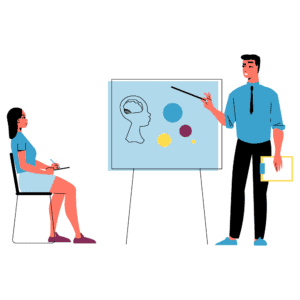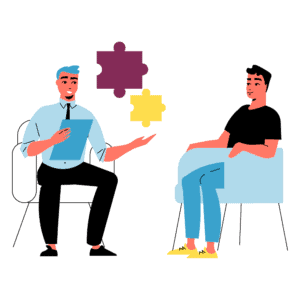Your XDi-Team
For people, by people
With good user experience design, successfully developing and marketing customer-oriented products is second nature.
Human Centered Design/User Experience Design means designing and coding websites, software, games, or apps with a focus on the individual user. Here, people are the guiding force behind every step of product development.
So, what exactly does that mean? Here, we’ll lead you through the basic principles of HCD – Both in and outside the digital world.
Furthermore, you’ll receive a detailed look into the most important topics concepts related to HCD. These make for both an exciting and emerging field of design. Finally, we’ll take a look at job prospects in the field.
USER-CENTERED DESIGN – PRINCIPLES, PHASES, PROCESSES
Human Centered Design stands at the center of digital economies.
Months of work invested in design and development and still the risk of a flop remains? Nowadays companies simply can’t afford it. HCD, however, is a win-win: Commercial success for the product and a pleasant user experience.
WHAT IS USER-CENTERED DESIGN? A CONSOLIDATED DEFINITION
User-centered design (henceforth HCD) refers to a collection of processes that place the user of a digital product or service at the center of its conceptualization and development. By providing a maximum level of user-friendliness, HCD seeks to increase the chances of success of the outcome of product development.
The ISO norm DIN EN ISO 9241-210 (2019), an internationally recognized standard for HCD, describes its six principles as follows:
The entire process occurs in four phases, which the ISO norm mentioned above also describes:
- 1. Understanding user needs
- 2. Determining requirements
- 3. Designing solutions
- 4. Testing and evaluating solutions
User Research
If HCD is implemented correctly, it results in products and services that offer users an unparalleled experience. User research is an indispensable part of generating this result. With and through it, the product’s designs and functions are created in line with users’ needs.
Service Design
An exciting overlap exists between user research and service design.
Service design, as its name suggests, is the process of conceptualizing and designing services. As a subtype of design, service design can also be implemented using sprints. Five phases are common in service design, and these largely resemble those in HCD: Research, identification of the problem, brainstorming, prototyping, and implementation as well as optimization.
The goal of service design is a sustainable solution to a problem in a given service environment.
USABILITY – THE TENET OF USER-FRIENDLINESS
One concept that has long been associated with user-centered approaches to design is usability. In broad strokes, usability refers to user-friendliness.
Concretely, usability is the extent to which users can sufficiently and effectively use a product - whether it be a service, system, or process - to reach pre-defined goals. Usability tests are one way to verify the user-friendliness of products and services.
The ten essential principles of interaction design, coined by Jacob Nielsen as “10 Usability Heuristics for User Interface Design”, are frequently employed guidelines in the field of usability.
DESIGN THINKING: AN APPROACH TO GENERATING INNOVATIVE IDEAS
Design Thinking is another problem-solving approach within agile UCD environments that challenges designers to assume specific attitudes (supplemented with specific phases and tools) to generate innovative ideas.
Note: Design thinking isn’t limited merely to product development. It can also be a useful strategy for life planning and solving larger problems rooted in society.

The most important difference between design thinking and UCD is perspective: Design thinking uses the big picture to drive innovation. UCD, on the other hand, is a model for finding tailor-made solutions rooted in an empathetic attitude toward users.
User Interface Design – UI Design
Designing user interfaces relies on so-called UI design. As in UX design, usability is a key component of UI design.

DESIGNING SCREENS, INFORMATION, AND INTERACTIONS
Interface design consists of three components: Designing screens, designing information, and designing interactions.
Common tools in the field of interface design are micro-interactions, dynamic panels, states, sketches, wireframes, and prototypes.

DESIGN MEDIUMS AND MOODBOARDS
Visual elements are an essential part of the design process. These come about through the application of different tools such as moodboards, which aim to define the overall style of the interface.
To create screen designs, interface designers can expect to work with both graphical elements (fonts, icons, graphics) as well as other media (animations, videos).

Styleguides and Design Systems
A style guide strictly defines recurring elements in an interface like colors, typography, use of images, grid, and navigational options. These guidelines allow third parties to design user interfaces according to the UI designers vision.

Design Patterns
patterns are reusable templates for recurring design challenges and problems. Design patterns have become an established part of both software development and architecture.

INFORMATION'S ARCHITECTURE
Information architecture describes a useful, easily navigable way for users to access the contents, search opportunities, and information contained within an interface.
Unsurprisingly, a well implemented information architecture contributes to better usability.
User Experience Design – UX Design
User experience design (UX Design) is the process of planning and designing the entire user experience with an interactive product, website, software, or app.
The core of UX design resides in creating a pleasurable and intuitive user experience. Therefore, UX design is an integral component of human centered design and is responsible for planning, designing, and developing a product’s interactive elements.
Although both processes focus on the individual user, UX design places heavier emphasis on devising solutions for the purely interactive parts of a product.
UI DESIGNER, UX DESIGNER: DO I NEED TO BE ABLE TO CODE?
The career possibilities surrounding HCD, UI design, and UX design are as exciting as they are broad. The good news is: Knowing a coding language isn’t necessarily a requirement. If you are only involved in design aspects, coding isn’t a prerequisite.
So, how does one become a human-centered designer? Again, good news: A specific degree isn’t necessary – Willingness to learn, however, has to belong to your repertoire.
Becoming a UX designer typically involves completing a design-related, informatics, or related digital design degree.
UI designers, on the other hand, often hail from diverse backgrounds, but generally have some knowledge in media and interface design or interaction design.
USER EXPERIENCE DESIGN AS PART OF USER CENTERED DESIGN
UCD is where concrete problems within digital products and services meet sensibility for understanding end users. It is truly an exciting career field with a range of opportunities for research and development.
Professional development in the field of UCD or UX design is one of the few ways to break into the tech field that doesn’t strictly require the ability to code. It’s an up-and-coming career path that can make our world a better, more empathetic and harmonious place – one user interface at a time.